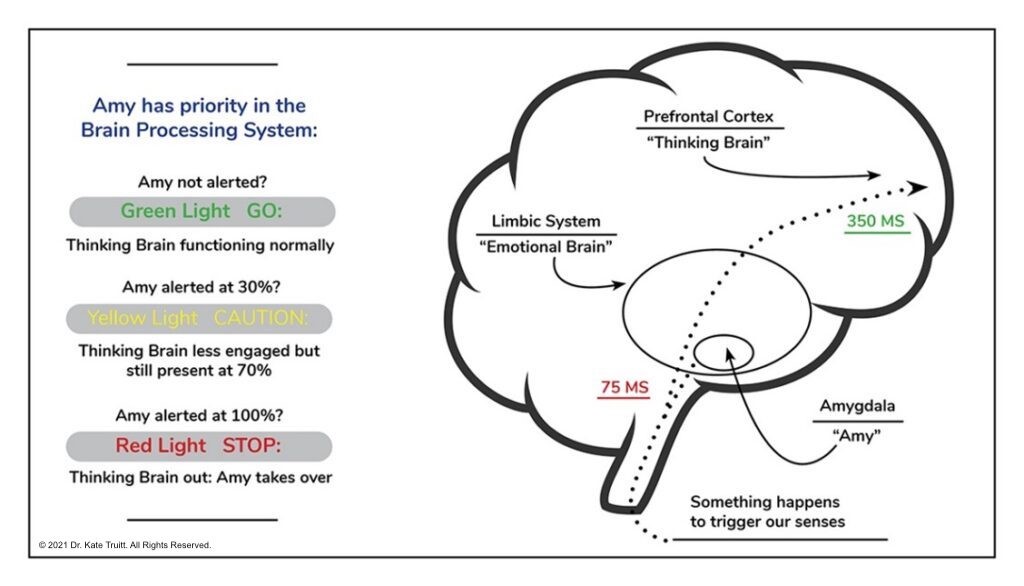Let’s talk Fear and get to know our Fear Brain: “Amy” the amygdala. Did you know that as humans, 90 percent of our present moment is informed by experiences from our past? These are the good, the bad, the ugly and even the unconscious! This is often not a bad thing, because a split-second decision made by our primal survival brain can keep us from stepping off of a cliff or running out into traffic to our deaths. Our fear brain’s Spidey sense, and memory system, deserves a lot of credit for making sure we stay alive. At the forefront of this process is the amygdala of our brains—our fiercest protector, which I call “Amy”—overriding our thinking brain in our brain’s information processing.
On the flip side, when we are living with increased stress, anxiety or fear, Amy’s hyperawareness of threat states can take on an overpowering role in our brain’s information-processing sequences. The problem with Amy’s threat assessment algorithm and its subsequent choice of action is that it may be based on something that Amy fears from 20 years ago that is no longer a problem in our current lives. When Amy finds something that is threatening enough to her to be memorable, she no longer has a sense of time, and her evaluation of the threat level can plunge us into less-than-preferable behaviors like lashing out in anger, withdrawing from other people, or choosing to ease our stress and anxiety with alcohol or other substances.
As a trauma survivor I have learned to recognize when Amy is sending up warning lights from my past. This ability to decipher her warnings in the context of what is happening in the present moment has empowered me to deepen my relationship with myself and develop methods for finding balance between what my amygdala would have me do, and what I would choose to do. In this article I want to show you some of those tools for resilience and explain how they work.
Calming the Fear Brain
In order to calm Amy down and get our prefrontal cortex (our thinking brain) to come online in our information-processing sequence, we need to understand Amy’s language. You see, Amy doesn’t speak English, French, ASL, Mandarin, or any other language. If you’ve ever tried to talk yourself out of your anxiety, then you know what I’m talking about. Amy actually speaks the language of electrochemistry. Amy is first to come online in that sequence at 75 milliseconds—about four times faster than the blink of an eye—whereas the thinking brain joins in much later, at 350 milliseconds (that is, if Amy allows it into the conversation at all). That means the amygdala is processing information about a given situation four times faster than our thinking brain is even aware that this is happening. The diagram below shows what that looks like.

The right side of the diagram shows the information-processing sequence and its timing. Something triggers one of our five senses and the amygdala gets the first crack at assessing what is happening and reacting to it. On the left of this diagram, you can see that when Amy is not alerted, your thinking brain is fully involved in the information sequence. If Amy is alerted at 30 percent, the thinking brain is still there but is only involved at 70 percent. If Amy is alerted at 100 percent, she takes over completely, and keep in mind that Amy is not only in a relationship with your brain, but with your whole body as well.
Amy doesn’t care about your quality of life—she just wants you to survive and, as I said, she’s quick about determining a solution. That’s O.K. if a mountain lion suddenly jumps into the path ahead, coming at you, and Amy causes you to instinctively remember what you learned at camp many years ago—to wave your arms wildly, make yourself look as big as you can and yell at the top of your lungs. What’s not cool is if Amy causes you to scream, cuss, honk, step on the accelerator, and tailgate someone on the freeway at 70 miles per hour because they just endangered you by cutting you off in traffic.
So how do we calm Amy down? It’s a process, because our thinking brains sometimes have little control over what the fear brain does in moments of stress. So, our work toward building a resilient brain has to be done initially outside of those moments so we can learn methods to use when those warning lights are thrown up. Resilience is a process that we can work on continually every day in our lives and calming the fear brain is part of that process. Let’s explore some ways we can do that.
Introducing you to CPR for the Amygdala®
CPR for the Amygdala, which stands for Creating Personal Resiliency for the Amygdala, is designed to help you regain physical and emotional balance when you find yourself in times of stress. In the following 12-minute video exercise, you will use the mindful touch of self-havening on your palms, upper arms, and face to generate slow, calming delta waves in the brain. With CPR for the Amygdala, the mindful touch is coupled with distractions, or “brain games,” that provide a sufficient level of distraction to stop your amygdala and the working memory from the amygdala’s tales of stress. Learn how to decrease anxiety and build resilience in this informative video.
Taking CPR for the Amygdala and Resilience a Step Further By Creating Possibilities
After we get Amy to calm down and feel safe by using CPR for the Amygdala Protocol and we are able to give the working memory a new job, we then want to look to creating new possibilities for how we would like to feel in certain moments, and for new overall pathways we would like to have in our lives. The Creating Possibilities Protocol is an opportunity for building those new neural pathways and supporting us in sustainably having the brain we would like to live in going forward—the sense of self through which we would like to navigate the world. The following 8-minute video shows how to create possibilities by using positive memories. The protocol I teach in the video is written for you below so you can cut and paste it for your own future practice.
Creating Possibilities Using Positive Memories:
1) While Havening, assess what emotion you would like to currently be experiencing and/or would like to carry with you into an experience. Recall a time where you felt that emotion.
2) While Havening, focus on that emotion and say the statement “What if I was _______”; repeat the statement 5 times.
3) While Havening, focus on that emotion and change statement to “I deserve to be _______”; repeat 5 times.
4) While Havening, focus on that emotion and change statement to “I am _______”; repeat 5 times.
5) Repeat the cycle of the three statements until the desired feeling is present.
Exploring More Possibilities
The two videos above are part of our “Healing Fear” Series on our YouTube channel. If you would like to take a deeper dive into healing the fear brain, you will find the entire series below.
In this video Dr. Kate invites you into a deeper understanding of how our fear brain impacts our ability to be our best selves on a day-to-day basis. There’s even a PowerPoint! When we are living in a state of increased tension, stress, anxiety, or fear our amygdala may start to play an overwhelming role in how our brain interprets information in our world. In these moments even the most neutral stimuli may be met with agitation, frustration, or anxiety. Have you ever overreacted to an incoming text message or someone’s tone of voice? Us too! That’s the impact of the amygdala on our brain functioning. In this series of videos, you will learn all about our dear survival-based friend “Amy” the Amygdala and the fierce protective role she plays in keeping us alive as well as how to help her not just slow down but also heal.
In this video Dr. Kate explores why and how our fierce warrior protector Amy the Amygdala remembers things and how we can help her forget the things that no longer need to be remembered. Let’s examine new opportunities for self-healing in our hands while moving into a compassionate awareness of how and why our Amygdala is fighting so hard to keep our safe. When we have an experience in our life that is big and scary enough then Amy records that data and superglues into our memory for easily accessible recall. The impact of this is triggers, stress, burnout, anxiety, depression, and more. When Amy starts to feel overwhelmed all the time then we will begin to navigate the world through fear glasses. (You got it: the opposite of those rose-colored glasses!) Understanding why this is happening is an important part of your self-healing and recovery journey. Knowledge truly is power!
Our Amygdala loves to gossip about all the scary things. Strange isn’t it? She’ll interact with many different brain parts creating her very own choose your own adventures of doom when she’s afraid. This results in increasing agitation, stress, anxiety, rumination and more. Oh our sweet “Amy”… she’s always trying to keep us safe at the cost of our quality of life! In this video Dr. Kate explores the relationship of the Amy the amygdala with the working memory and prefrontal cortex and discusses the role Amy plays in defining our sense of self in the world around us. When we help Amy heal, we are empowering ourselves to build resilience and agency. Come learn how to stop those ruminating thoughts that cause so much pain and beginning building your resilient neuro-garden!
CPR for the Amygdala is an easy-to-use tool for calming the mind and body in a moment of emotional hijack. Watch this short video and learn how to calm your brain through the engagement of the Self-Havening touch and brain exercises. A fast brain is a reactive brain, and a slow brain is a calm brain. Let’s calm the mind and put you back in charge of your emotional state.
Did you know our brain is capable of growing and changing across the course of your life? This concept is called neuroplasticity. We have the ability to actually train our brain into an empowered and resilient state.
In this video Dr. Kate teaches a new protocol for harnessing the power of Neuroplasticity to create new neural pathways and build your resilient brain. Happy Brain Building!






